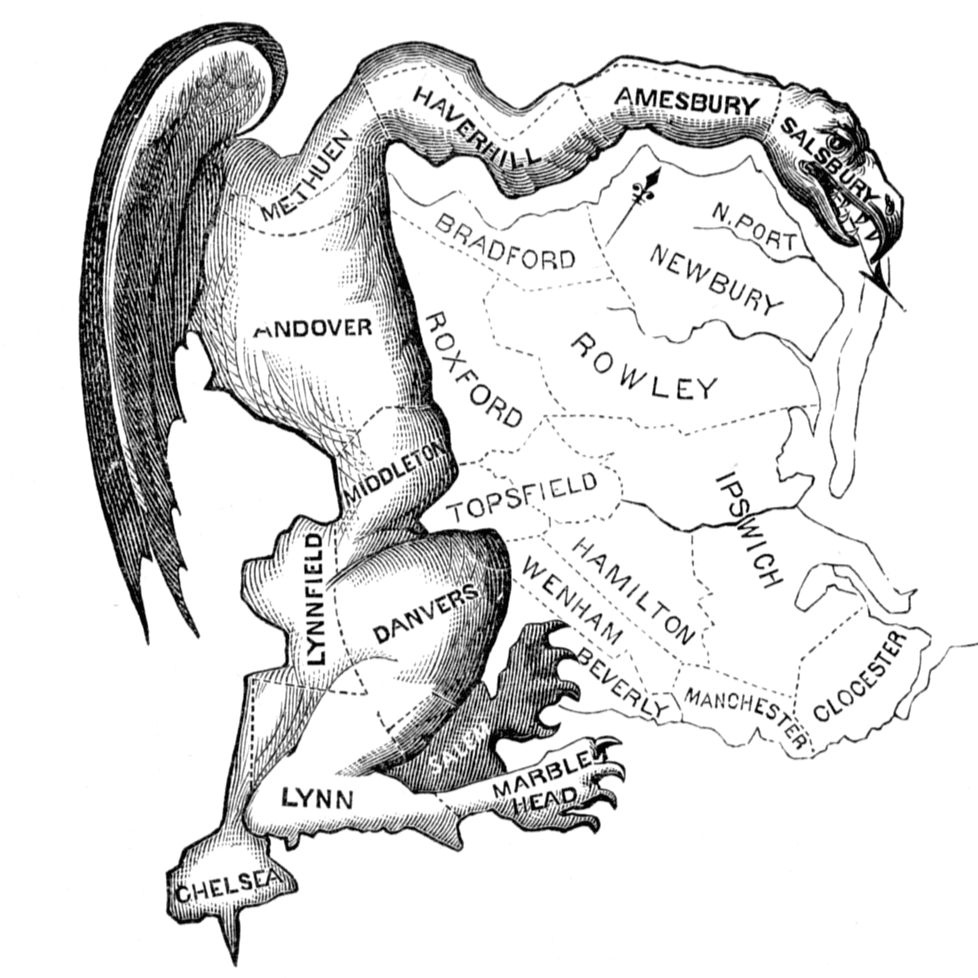
Navigating the Labyrinth: Independents and Gerrymandering
An effort to list everything that’s wrong with politics in America would take more space and words than the scope of this article will allow. Instead, we’ll focus on one problem that’s caused incalculable damage to our electoral system, but may be one of the simplest to solve: gerrymandering.
It’s an issue that would only take a little common sense and cooperation to fix.
But, running for office in a gerrymandered district is almost fruitless. When you’re an independent candidate, it's akin to taking on a formidable Goliath armed with only a slingshot and sheer determination.
The practice of gerrymandering is nearly as old as the Republic itself. Originally, congressional redistricting was created with the fairly benign intentions of reflecting changes in population and ensuring equal representation in districts with smaller populations.
However, the process has become a pervasive issue in recent years. If you think that our description of gerrymandering as a labyrinth is hyperbolic, check out this map and overview of the most gerrymandered districts in America.
Let’s delve into the concept of gerrymandering, describe its detrimental effects on both voters and candidates, examine examples of famously gerrymandered districts, and offer valuable tips for independent candidates who dare to challenge this political labyrinth.
Gerrymandering: An Unseen Enemy of Democracy
Gerrymandering, for those not well-versed in the world of politics, is the practice of manipulating the boundaries of electoral districts to favor one political party over another. The term itself dates back to 1812, coined after Massachusetts Governor Elbridge Gerry approved a suspiciously odd district boundary line to benefit his Democratic-Republican Party.
The vaguely reptilian-shaped outline led one editor from the Boston Gazette to remark that it looked like a salamander, and thus the term “Gerrymandering” was coined.
Humorous as the origins of the term are, this type of political maneuvering seriously distorts the democratic process by making elections less competitive and rendering many votes meaningless.
The lines are drawn by state legislatures every 10 years after the US Census is taken. Thirty-four states allow legislatures to have complete control over the configuration of their own district lines, while 39 states give the legislature control over all congressional districts within their state. Four states (Iowa, Maine, Utah, and Vermont) rely on advisory commissions to help legislatures draw representational districts.
The effects of gerrymandering are profound and pervasive, but it is in gerrymandered districts that the impact is most acutely felt. Here's a closer look at how gerrymandering harms both voters and candidates.
How Gerrymandering Hurts Voters
Gerrymandering has the effect of stacking the deck in favor of whomever is the majority party in a state at any given time, but it has wider effects that all candidates and voters should care about. Once districts are drawn, it’s almost impossible to undo the damage until the next census. Those propelled into office under gerrymandering can cause more damage, and it takes much longer to mitigate.
Here are some of the hidden dangers of gerrymandering:
Voter Disenfranchisement: In gerrymandered districts, voters often find themselves effectively disenfranchised. When district boundaries are manipulated to ensure one party's dominance, the outcome of the election becomes predetermined. This discourages voter participation while fostering apathy and disillusionment. Why vote if your voice won’t be heard?
Polarization and Extremism: Gerrymandering contributes to political polarization and extremism by creating "safe" seats. In these districts, candidates have no incentive to appeal to the political center, as winning the party primary is often enough to secure victory in the general election. This results in candidates who cater to their party's base, pushing more moderate voices aside. In the 2022 general election, 35 districts had only one party represented on the ballot. Lauren Boebert, who narrowly won her last race, only holds her seat due to running in a district that’s Republican +8. That means people in her district vote Republican at a rate that’s 8% higher than the national average. One could speculate that, without gerrymandering, no one outside of her home town in Colorado would know her name.
Minority Vote Suppression: In many cases, gerrymandering dilutes the power of minority votes. Minority communities are often divided into multiple districts, minimizing their impact on elections. This not only diminishes the influence of minority voices, but also perpetuates systemic inequalities.
Electoral Barriers: By drawing representational boundaries so that they favor one party or candidate over another, gerrymandering creates an additional barrier for independents and other unaffiliated candidates. This further consolidates power into the hands of establishment loyalists from both parties while stifling independent voices and representation.
Infamous Examples of Gerrymandered Districts
We don’t have to imagine how extreme congressional redistricting impacts elections. Pundits can speculate, but there are too many real-world examples available.
Here are some of the more egregious:
North Carolina's 12th Congressional District
One of the most notorious examples of gerrymandering is North Carolina's 12th Congressional District. Created in 1992, the district's boundaries were drawn in a way that connected African American communities through a narrow corridor that stretched over 160 miles. This configuration aimed to concentrate black voters into a single district, making it highly unlikely that an African American candidate would be elected, while also weakening their influence in surrounding districts.
Since that time, North Carolina’s districts have been redrawn several times, with the infamous 12th District finally being contained entirely in Mecklenburg County. The state had a similar issue when Districts 1 and 4 were gerrymandered. Initially, these new boundaries were upheld despite challenges. However, the State Appeals Court finally determined that the current state of the gerrymander was unconstitutional and ordered the districts to be redrawn without using racial demographic data.
This one small change resulted in the loss of two GOP seats after the 2020 election.
Maryland's 3rd Congressional District
The 3rd Congressional District of Maryland is another prime example of gerrymandering, though this time it was Democrats who employed the practice. The district's boundaries were artfully drawn to include disconnected pockets of Democratic voters, all but guaranteeing a Democratic victory in each election. However, some referred to the redistricting as “religious gerrymandering” due to the number of synagogues concentrated within its boundaries at the time. This type of partisan manipulation deprives voters of genuine choice and fosters political polarization.
Wisconsin's State Legislative Maps
In Wisconsin, gerrymandering has been taken to the extreme, though there are plans in the works to change this. The state's legislative maps were drawn in such a way that, in the 2012 elections, Republicans won 60 of 99 state assembly seats with just 48.6% of the vote. This glaring disparity between votes and seats illustrates how gerrymandering can skew political representation and silence the voices of the people.
As of 2022, Republicans hold a 64 - 35 advantage in the state’s assembly and a 2:1 majority in the Senate. This is despite having a Democratic Governor, Attorney General, and Secretary of State.
Tips for Independent Candidates Running in Gerrymandered Districts
Running for office as an independent candidate in a gerrymandered district is an uphill battle. However, with the right strategy and some determination, it is not an impossible feat.
Here are some essential tips for those who dare to take on this challenge:
Know your district inside out. To have any chance of success, it's imperative to know your gerrymandered district intimately. Understand the demographics, the issues that matter most to constituents, and the unique challenges they face. This knowledge will enable you to tailor your campaign message effectively.
Build a strong grassroots movement. Independent candidates often lack the institutional support that major parties offer. To compensate for this, focus on building a robust grassroots movement. Connect with local activists, community leaders, and concerned citizens who are passionate about reforming the political system. Grassroots support can help offset the financial disadvantages independent candidates often face.
Embrace transparency and accountability. Make transparency and accountability the cornerstones of your campaign. Highlight the injustices of gerrymandering, be candid about your positions, and demonstrate a commitment to fairness in the electoral process. Engage with voters directly through town hall meetings, online platforms, and community events to instill trust.
Forge strong coalitions. In gerrymandered districts, you may not be the only candidate facing this issue. Reach out to like-minded candidates from various backgrounds who share your concerns about gerrymandering. Forming coalitions can amplify your message and increase your chances of making an impact.
Try some innovative campaigning. Think outside the box when it comes to campaigning. Leverage social media and digital marketing to connect with voters and raise awareness. Engage in door-to-door canvassing, host informational events, and make your presence known at local gatherings. Independent candidates often have unique stories and perspectives to offer, so use them to your advantage.
Initiate legal challenges. Consider exploring legal avenues to challenge gerrymandering in your district. Work with organizations that focus on electoral reform and redistricting issues. Courts have increasingly scrutinized gerrymandering, and your candidacy could provide an opportunity to shed light on the problem.
Emphasize your independence. Embrace your status as an independent candidate. Use it to your advantage by emphasizing your freedom from party politics and your commitment to putting the people's interests first. Appeal to voters who are disenchanted with the two-party system and looking for a fresh, non-partisan perspective.
Final Thoughts
Running for office as an independent in a gerrymandered district is a Herculean task, but it's not insurmountable. Gerrymandering is a deeply entrenched issue in American politics, and it has far-reaching consequences for both voters and candidates. Despite challenges based on the violations of the 14th amendment guarantees of due process and equal protection under the law, the Supreme Court has consistently ruled that gerrymandering is a political question and not applicable to remedies under the federal court system.
However, those who are determined to challenge this system can make a difference.
By knowing your district, building grassroots support, embracing transparency, and using innovative campaign strategies, independent candidates can bring attention to the issue of gerrymandering and potentially change the course of American democracy. It's a daunting path, but one that is essential for the health of our democracy and the representation of the people's true voices.
Join Our Fight to Smash the Two-Party System
If you’re tired of finding the political deck stacked against you, GoodParty.org offers solutions. Our knowledge base is designed to provide further information about the American political system for voters and candidates, and we provide free tools and resources to help independents run for office and win at the local, state, or national levels.

